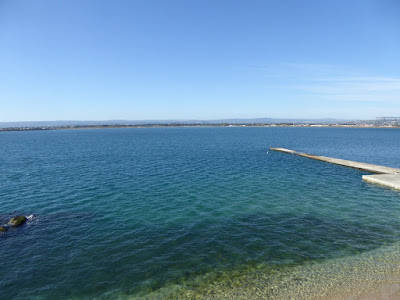Annamaria on Monday
Today I am harkening back to a post from 9.75 years ago. Yesterday, Brother Jeff talked about that proverbial question for novelists: where do you get your ideas. Here is the story of my first week-long stay in my ancestral city of Siracusa. I have been back a few times. (But not enough. For me there is never enough). My ideas almost always start with a place.
The visit this blog describes started a story pouring out of that place in my head where (it feels like to me) all my stories come from. It is a story like some others I have written, but also a departure a significant way.
I worked on that story while I was also continuing with my East Africa series. I had a good draft done by the dawn of 2019, when a tsunami of four bad/dumb issues hit the proverbial fan. They began with a publishing snafu, and the last was Covid. Now, I have real hopes for that story, which was inspired by my visit to Siracusa.
 |
| First view of Etna while landing at Catania |
I came to Sicily last Monday and found the weather of a lovely
day in June in New York. The richness of
my experience that over this past week defies communicating in one blog post.
If they asked me, I could write a book about this place and what it means to me
and to the rest of the civilized word. I
will tell you more about it over the next few weeks. Today, I will begin with my first two days alone
in Siracusa and confine this post to the Ortigia—the island that comprised the city’s
power center during ancient times and that is now, in its entirety, part of the
Patrimony of Humanity. (It does not
include, by the way, the ancient ruins and the in-tact Greek theater, one of
best preserved in the world, that are on the mainland. We can go there another time.)
The area around my ancestral city was inhabited in
prehistory. The first Greek settlers
came to this island in 734 BC. By 500
BC, Siracusa had overflowed the original island settlement and was as large as
Athens. Eventually, it became the
capital of Magna Grecia. I first visited
in 1979 and have been back six or seven times.
But this time I came with a story in mind and there were specific things I wanted to look at that are important in the lives and movements of my
characters.
Let me show you just some of what I saw.
After checking in—
 |
| A view from my room. This port is where a major battle of the Peloponnesian Wars took place, when Siracusa defeated Athens. |
 |
| Another view, toward the mainland part of the city |
I headed straight for the Piazza del Duomo to visit the place of
greatest interest for me, given my story, and for anyone who comes here: the
Duomo itself. The Greeks built a
fabulous Doric temple on this spot. When
the first Christian sanctuary in Europe was built here, the architects
incorporated the temple structure. You
don’t see the likes of this anywhere else.
 |
| Entering the Piazza del Duomo |
 |
| The Baroque facade. |
 |
| From the side view you can see the Doric columns of the Temple of Athena, built by the Greek colonists in 500BC. |
 |
| Here is the other side of that exterior wall, again with the columns in plain view. |
I have so many gorgeous things I want to show you, but I’ll have to stop now because the Wi-Fi where I am today is very slow and
unstable, and we may see the turn of the next millennium before all the photos I would like to show you upload. Besides. we have to
be kind to Jeff and make sure that his level of envy does not reach apoplectic
proportions.
As we say here, a presto
(See you soon). Presto is a word that does not apply to the speed of my Wi-Fi while working on this blog.
Here a few more shots taken on subsequent visits, with a better camera.




















The envy is not restricted to Jeff! Wonderful photos and scenes, Annamaria.
ReplyDeleteI'm glad you like them, Michael. I have lots more. Wait till next week. You'll want to book a flight and join me. Which would be great fun.
DeleteBeautiful pictures of such a fascinating place.
ReplyDeleteThanks,Triss. It is super gorgeous, and the skies seem bluer here than anywhere.
DeleteLovely, AmA! (Kept short in cognizance of your circa 500 B.C. Wi-Fi...)
ReplyDeleteOY, EvKa, what you see above took over four hours and a lot of gnashing of teeth. If I had had an AK47, I would have gone to find the modem and emptied a cartridge into it.
DeleteAbsolutely beautiful. Eagerly await more photos and history.
ReplyDeleteI can see that I have to read up on this history.
The envy I have is that you have wifi. I am in a hotel in Washington PA where not only did the ancient Greeks likely construct it, but current management is trying to maintain the same 2500 years ago feel. So there!
ReplyDeleteThese are lovely! The blues (both sky and sea) are magical. Thank you!
ReplyDeleteI am glad you like them, Ovidia. They are pictures of Sicily in Winter. For a person like me, who grew up in a mid-Atlantic state that is mostly gloomy in the winter months, those blue skies seem magical.
DeleteBoth stunning and stark against the sky.
ReplyDeleteThank you, Sara. It looks that way in the photos, but it is not stark when one is there. The Sicilian people are, generally speaking, warm and friendly.
Delete